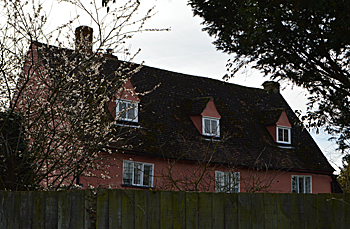Brook End Farm Keysoe
![Brook End Farm about 1960 [Z53/69/5]](/CommunityHistories/Keysoe/Keysoe-Images/Brook-End-Farm-about-1960-Z53-69-5.jpg)
Brook Farm about 1960 [Z53/69/5]
In August 1983 the former Department of Environment listed both Brook End farmhouse and the barns that border it as Grade II, of special interest. The farmhouse probably dates from the 17th century and is timber-framed, with some roughcast and some brick infill, the whole thing being colour washed. The roof is composed of old clay tiles and the building forms a T-plan, the main block having two storeys and attics and the rear wing one storey and attics. The porch is 19th century. The barns are 18th and 19th century. The large four-bay barn is 18th century “listed for its own intrinsic merit”. It is constructed from weather-boarding over a timber frame on brick plinth with a pantiled roof. The three barns to the north-west of this which form a link between the barn and the farmhouse are listed for their group value and are a mixture of 18th and 19th century date.
The farm may, perhaps, have formed part of either the Manor of Keysoe Grange, or the Manor of Keysoe Bury. By the late 18th century, land at Brook End was owned by the Crawley family of Stockwood Park, Luton, who were lords of both manors. In 1783 repairs to this land were required [C1690]. In a terrier of 1790 [C1697] three tenants are described as owning land at Brook End: Matthew Sturges with 168 acres; John Claridge with 177 acres and William Crockford with 151 acres. These reerences may, of course, have nothing to do with Brook End Farm and, certainly, there are no further references in the Crawley family archive!
In 1914 Benjamin Hartop bought the farm from the landlords whose names were Newell [BMB4/1/17/36/1-5], farmers at Brook Farm. The Rating and Valuation Act 1925 specified that every building and piece of land in the country was to be assessed to determine its rateable value. The valuer visiting the farm [DV1/H41/20] found it was owned and occupied by Benjamin Hartop, the former tenant, and comprised 265 acres. The valuer commented: “Mr H away, saw foreman”. A colleague wrote: “Know it by heart. 30 acres of big field only left in arable out of 168 and rest arable south of road. Bad Farm. Good homestead, poor house. Nice sheds in yards”.
The “poor” house contained three reception rooms, a kitchen, scullery and dairy with four or five bedrooms above and three attics above them. The valuer noted: “Foreman lives here”. The homestead contained the following: eight cow stalls; a three-bay hovel; two chaff houses; a stable for six horses; a granary; a three-bay hovel; a barn; three loose boxes; a five-bay hovel; a hen house; a barn “with mill”; three piggeries; a two-bay hovel; a loose box; a coal house; another loose box; two hen houses; three more piggeries; an engine house; a three-bay sheep hovel; a six-bay cart shed; a garage and an implement shed.

Brook End Farm March 2016
In 1931 Benjamin Hartop’s executors put the farm up for sale. The particulars [BML10/39/1] state that the farm comprised 261 acres, 3 roods, 13 poles, of which 106 acres, 2 roods, 26 poles were arable. The farmhouse had a porch entrance, hall, dining room, drawing room, kitchen, scullery and dairy on the ground floor. Above this were five bedrooms, three attics and a “man’s room over scullery”. A wood shed and an earth closet were outside, along with “a productive kitchen garden and a flower garden in front of house”.
In 1969 consideration was being given by the government to building a third London airport. One of the candidates was the old airfield at Thurleigh. A protest lobbying ground called Bedford Airport Resistance Association was created to oppose the scheme. Part of the publicity was a photograph, originally accompanied by the following text [Z118/F/9/1 ]: “William Ward, 30, farms 430 acres around Keysoe and his farm, Brook End Farm, is directly in the path of a proposed runway. Moving will not simply be a matter of buying a farm in another area. William has grown up with a particular soil analysis and knows how to get the best out of his land. Locally he is respected as a good farmer. Looking for a new farm means finding land with a similar soil analysis. If this cannot be found available in this country, Britain stands to lose. For Mr.Ward has already given thought to emigrating to Australia, a country where there is land to spare. Mrs. Ward, mother of two children, is one of the originators in the fight against an airport. ‘We are muddy boot farmers like most of the farmers round here and the land is too good to waste when the world is crying out for increased food production’. The Wards, with Giselle, one of their children, are seen during harvesting with their full-time help, Duncan Blair. Duncan lives in a cottage on the farm with his wife and four sons”. Fortunately for all concerned the airport was built in none of the locations originally chosen, rather the situation was dealt with by expanding Stansted in Essex.
In 2008 the farmhouse was again for sale. The particulars [Z449/2/7] Sale particulars describe a hall, a family room, a sitting room, a dining room, a farmhouse kitchen, a pantry, a side lobby, a shower room, a utility room and a studio bedroom on the ground floor with four bedrooms and a bathroom on the first floor and three attic rooms on the second floor.

Barns at Brook End Farm March 2016